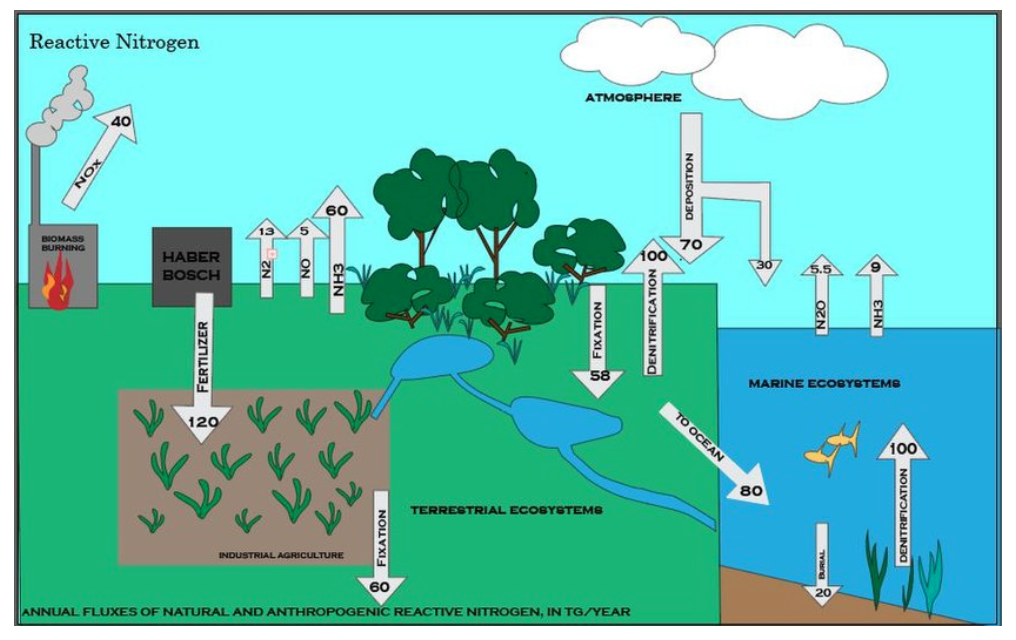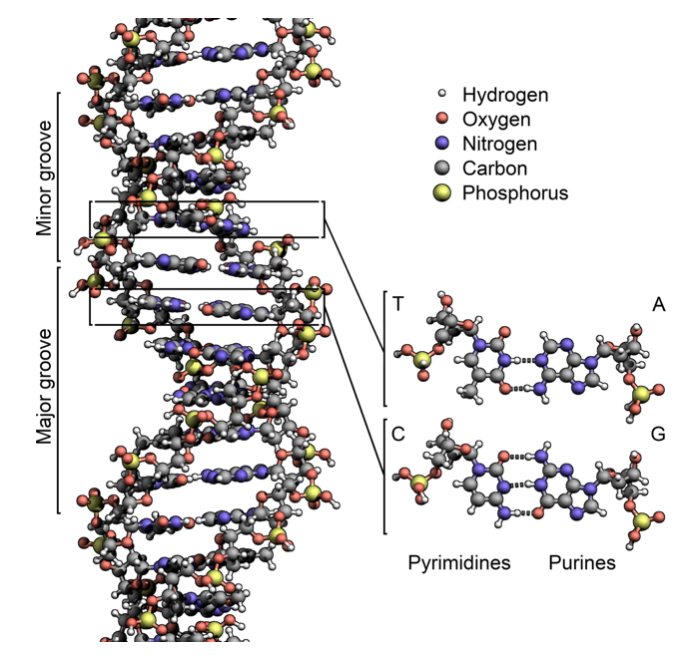
Nitrogen Cycle
4 min read•november 23, 2021
Fatima Raja
Fatima Raja
Movement and phase changes of nitrogen.
The Nitrogen Cycle is in some ways the literal backbone of our ecosystem. It’s one of those things that if for whatever reason stopped working, we would be in big trouble! 🦴
Luckily, we don’t really need to worry about that. 🍀
Before we talk about exactly what the nitrogen cycle is and the steps that it’s composed of, let’s get a more foundational understanding of what exactly nitrogen is and the role it plays in our environment. 🎉

Image courtesy of Wikipedia
What is Nitrogen?
First, here are some fast facts about Nitrogen:

Image courtesy of Wikipedia
Elemental Symbol: N
Atomic Number: 7
Group: 15
Atomic Mass: 14
Nitrogen is usually found in the gaseous state (that’s its normal state).
💡 Fun Fact: Nitrogen is the most abundant state in the entire atmosphere. It makes up around 80% of the air we breathe!
Why do we need Nitrogen?
You might not realize it, but nitrogen is a necessary component to many parts of our lives. ❕
At the most basic level, Nitrogen is a part of the DNA, proteins, and amino acids that make up our bodies. Without them, we would not be alive! It’s also part of what makes up chlorophyll in plants (that’s the stuff that makes them green and helps them with photosynthesis).

Image courtesy of Wikipedia
It also plays a pretty significant role in our day-to-day lives. In fact, we can find nitrogen in things like antibiotics, caffeine, and morphine. 😌
Where do we get Nitrogen?
At this point, you must be thinking, “Wow, nitrogen is actually really important to me staying alive, but it’s not like I’m constantly thinking about how much nitrogen I’m consuming. Where does it all come from?” ❓
It mostly gets into our bodies through the food we eat! You know that saying “you are what you eat”? Well, when it comes to nitrogen, it applies in the literal sense. 🍉
Nitrogen is mostly in the vegetables and fruits we eat. It’s also in meats and dairy products, so you don’t really need to keep track of the exact amount of nitrogen you’re consuming because it’s already (and always has been) in the foods you eat! 😋

Image courtesy of Wikipedia
But, remember how earlier I said that nitrogen is around 80% of the air we breathe? Well, you might be wondering why breathing isn’t one of the ways people get nitrogen into our bodies. Most organisms like animals and humans can’t absorb nitrogen into our bodies when it’s in gaseous form. Since that’s the state of matter nitrogen takes in the atmosphere, we can’t just breathe nitrogen in and call it a day. 😔
And that, my friends, is where the Nitrogen Cycle comes into play! 🎲
What’s the Nitrogen Cycle?
The Nitrogen Cycle explains how nitrogen moves from the atmosphere into plants and animals and then back into the atmosphere after that. 🌱
Just like the water cycle, it’s composed of a few different steps that repeat over and over again and never really stop. On top of that, it’s another cycle that’s foundational to keeping our environments working. 👍
There’s a few different steps to the Nitrogen Cycle, so let’s get into it!
1 Step #1: Nitrogen Fixation
What do lightning and bacteria have in common? (Hint: this isn’t a really bad joke, though I’m sure there’s probably one about nitrogen out there. Google's your best friend!) ⚡🦠
That’s right! They “fix” nitrogen. While nitrogen isn’t really broken in any way and completely perfect just the way it is, it isn’t usable by animals in gas form. ❌
So, when we say that lightning and bacteria are "fixing" nitrogen, we just mean that they’re converting it into a form that plants can absorb. Fixation is the first step in getting it to animals to eat and plants to use in their photosynthetic process. 🌞
2 Step #2: Mineralization
This step is less a step that’s super independent and happens right after Step #1 and more something that happens simultaneously. If you want to, you can think of it as Step #1, Part #2. 😁
Anyhow, mineralization is where decomposing plants and animals or manure (less formally known as poop) is taken and converted into ammonia and then ammonium (which is usable by plants). It’s pretty similar to decomposition, and the ammonium is held in the soil for use by plants that need nitrogen but didn’t get in through nitrogen fixation! 🔨
3 Step #3: Nitrification
This step, like mineralization, also happens in the soil. The ammonia that’s in the soil, which we talked about in the last step, is turned into nitrites and nitrates. 🌿
Nitrates are our faves because they can be used by the organisms that eat the plants that have them! 🤝
On the other hand, nitrites must be turned into nitrates before plants and animals can use them. We love them even though they require that extra step! 💖
4 Step #4: Denitrification
This is where our love story with the Nitrogen Cycle ends.
Nitrogen goes back to the atmosphere (where it came from), and nitrates are turned back into nitrogen gas by bacteria!
Don’t be too sad, though. The cycle just starts over once again! Sounds like any other cycle, right? ⭐
Nitrogen Cycle
4 min read•november 23, 2021
Fatima Raja
Fatima Raja
Movement and phase changes of nitrogen.
The Nitrogen Cycle is in some ways the literal backbone of our ecosystem. It’s one of those things that if for whatever reason stopped working, we would be in big trouble! 🦴
Luckily, we don’t really need to worry about that. 🍀
Before we talk about exactly what the nitrogen cycle is and the steps that it’s composed of, let’s get a more foundational understanding of what exactly nitrogen is and the role it plays in our environment. 🎉

Image courtesy of Wikipedia
What is Nitrogen?
First, here are some fast facts about Nitrogen:

Image courtesy of Wikipedia
Elemental Symbol: N
Atomic Number: 7
Group: 15
Atomic Mass: 14
Nitrogen is usually found in the gaseous state (that’s its normal state).
💡 Fun Fact: Nitrogen is the most abundant state in the entire atmosphere. It makes up around 80% of the air we breathe!
Why do we need Nitrogen?
You might not realize it, but nitrogen is a necessary component to many parts of our lives. ❕
At the most basic level, Nitrogen is a part of the DNA, proteins, and amino acids that make up our bodies. Without them, we would not be alive! It’s also part of what makes up chlorophyll in plants (that’s the stuff that makes them green and helps them with photosynthesis).

Image courtesy of Wikipedia
It also plays a pretty significant role in our day-to-day lives. In fact, we can find nitrogen in things like antibiotics, caffeine, and morphine. 😌
Where do we get Nitrogen?
At this point, you must be thinking, “Wow, nitrogen is actually really important to me staying alive, but it’s not like I’m constantly thinking about how much nitrogen I’m consuming. Where does it all come from?” ❓
It mostly gets into our bodies through the food we eat! You know that saying “you are what you eat”? Well, when it comes to nitrogen, it applies in the literal sense. 🍉
Nitrogen is mostly in the vegetables and fruits we eat. It’s also in meats and dairy products, so you don’t really need to keep track of the exact amount of nitrogen you’re consuming because it’s already (and always has been) in the foods you eat! 😋

Image courtesy of Wikipedia
But, remember how earlier I said that nitrogen is around 80% of the air we breathe? Well, you might be wondering why breathing isn’t one of the ways people get nitrogen into our bodies. Most organisms like animals and humans can’t absorb nitrogen into our bodies when it’s in gaseous form. Since that’s the state of matter nitrogen takes in the atmosphere, we can’t just breathe nitrogen in and call it a day. 😔
And that, my friends, is where the Nitrogen Cycle comes into play! 🎲
What’s the Nitrogen Cycle?
The Nitrogen Cycle explains how nitrogen moves from the atmosphere into plants and animals and then back into the atmosphere after that. 🌱
Just like the water cycle, it’s composed of a few different steps that repeat over and over again and never really stop. On top of that, it’s another cycle that’s foundational to keeping our environments working. 👍
There’s a few different steps to the Nitrogen Cycle, so let’s get into it!
1 Step #1: Nitrogen Fixation
What do lightning and bacteria have in common? (Hint: this isn’t a really bad joke, though I’m sure there’s probably one about nitrogen out there. Google's your best friend!) ⚡🦠
That’s right! They “fix” nitrogen. While nitrogen isn’t really broken in any way and completely perfect just the way it is, it isn’t usable by animals in gas form. ❌
So, when we say that lightning and bacteria are "fixing" nitrogen, we just mean that they’re converting it into a form that plants can absorb. Fixation is the first step in getting it to animals to eat and plants to use in their photosynthetic process. 🌞
2 Step #2: Mineralization
This step is less a step that’s super independent and happens right after Step #1 and more something that happens simultaneously. If you want to, you can think of it as Step #1, Part #2. 😁
Anyhow, mineralization is where decomposing plants and animals or manure (less formally known as poop) is taken and converted into ammonia and then ammonium (which is usable by plants). It’s pretty similar to decomposition, and the ammonium is held in the soil for use by plants that need nitrogen but didn’t get in through nitrogen fixation! 🔨
3 Step #3: Nitrification
This step, like mineralization, also happens in the soil. The ammonia that’s in the soil, which we talked about in the last step, is turned into nitrites and nitrates. 🌿
Nitrates are our faves because they can be used by the organisms that eat the plants that have them! 🤝
On the other hand, nitrites must be turned into nitrates before plants and animals can use them. We love them even though they require that extra step! 💖
4 Step #4: Denitrification
This is where our love story with the Nitrogen Cycle ends.
Nitrogen goes back to the atmosphere (where it came from), and nitrates are turned back into nitrogen gas by bacteria!
Don’t be too sad, though. The cycle just starts over once again! Sounds like any other cycle, right? ⭐

Resources
© 2024 Fiveable Inc. All rights reserved.
AP® and SAT® are trademarks registered by the College Board, which is not affiliated with, and does not endorse this website.